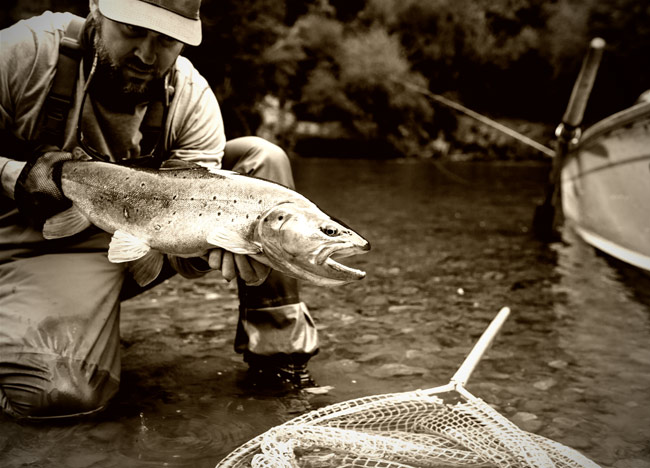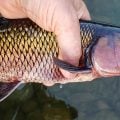All You Need to Know You Learned in Michigan
It was about a year ago this week that I found myself not typing away in chilly Michigan but casting away in Chilean Patagonia, where the rivers were blue, the glaciers chalky white, the brown trout legion. One day stands out in particular, for no other reason than I was the hottest hand west of the Andes.
It was guide’s day off, and I was fishing with two local anglers enjoying some R & R—and by “fishing with” I mean “definitively outfishing,” which was as awkward for me as it was for them. They took my first few big scores in stride and simply laughed and asked what I had for breakfast, but when the trend of more and bigger fish continued through the afternoon hours, the laughter was replaced by creased brows and silence. And when I released what was far and away the day’s largest fish at dusk, one of my partners cleared his throat and made an indecent proposal: “How much for one week with your fly box?”
While my results that day may have been exceptional, my approach was anything but. No matter where I’m fishing streamers for brown trout, I generally have only one game plan: make like I’m fishing back in Michigan.
I know, of course, that there are great streamer anglers and streamer innovators all over the country. But it also can’t be denied that quite a few cool streamer technologies have come out of the Great Lakes State, starting with those of our most eminent émigré, Kelly Galloup. Throw in Tom Lynch’s Drunk and Disorderlies, Russ Maddin’s Circus Peanuts, and Mike Schultz’s Swingin’ D’s and rabbit fur creations and it becomes clear you could do much worse than throw Michigan streamers all day, every day. Maybe it’s because we’ve had brown trout since 1880, or that we’ve had a competitive fly fishing guide culture since the Civil War era (in pursuit of the now-extinct Michigan grayling), but the fact of the matter is that the Michigan streamer school plays well wherever alpha brown trout are found. Here’s a crash course of getting your streamer game on in the tried and true style of the Mitten State.
Watch Your Fly
Whether you tie your own streamers or purchase them from commercial tiers, you should always evaluate the way your fly swims every time you use one. Brown trout refuse dry flies because they look wrong. Brown trout refuse streamers because they swim wrong. And it’s true that not all flies are created equal. The best commercial tiers take pains to put out a dependable product, which means sourcing uniform ingredients and applying them with machine-like consistency. But for most tiers, this level of streamer regularity can be a good deal harder to achieve. Take a look at a rabbit zonker and you’ll see that the hide widens and thins even in the same strip. Schlappen stems, likewise, vary in stiffness even on the same bunch. Deer-hair fibers are thicker on this hide than the other, and so on. It’s been my experience that of any dozen streamers some will swim great, some will swim average, and some should be broken down and used for parts—or gifted to known low-hopers. Because flies are never going to be a totally uniform element, and even those that start out swimming great will eventually have to be retired, it’s always good to be on the lookout for underperforming specimens.
Be Deliberate About Materials
Two-handed anglers pay close attention to how different materials in their swing flies respond to different currents. Stiffer fibers like bucktail or black bear maintain their body in faster flows where softer materials like marabou or ostrich hurl might collapse. But throw that stiff stuff into a soft slick and they don’t have nearly as much action as palmered rabbit fur or a Finn raccoon wing. If you strip streamers, you should be thinking about your fibers as well. Do the conditions call for fishing flies fast and enticing fish to give chase? If so, it’s better to select flies with longer, stiffer tail fibers—think larger saddle feathers or schlappen—which respond better to faster and more volatile retrieves. When you need to fish lower and slower and require more passive action, look to your soft-fiber streamers—AKA rabbit fur or marabou—tied partly or entirely in the round.
Control Your Boat
In the case of articulated streamers, 50 percent of the strip is the stop, the pause, the recovery. While it might only last a fraction of a second, it’s in that second half of the stripping equation that an articulated fly can kick it’s rear portions out and away from the head of the fly and do it’s best impression of floundering food. The key to keeping that action sharp and consistent is to avoid any dampening, and dampening comes from drag. In the case of sinking lines fishing from a moving boat, drag comes from moving either slower or faster than the current. Go too slow and your line will bow downstream of the boat, pulling the fly forward when it should be recovering. Go too fast and it’ll be the boat, and not the current, pulling the fly downstream. In both cases the end result is the same: a streamer that doesn’t swim nearly as well as it should.
So how do you solve this problem? By communication with the guy or gal on the sticks. Mind you this is a lot easier when you’re fishing with a regular partner. During the fall a friend of mine wondered aloud why we tend to be so successful when fishing together. The best answer I could come up with was we were comfortable enough to bark at each other if the boat was moving in a way that didn’t complement our fishing. What might have looked like verbal abuse from the outside was really just the best kind of streamer teamwork.
Fish With Both Hands
Once proper boat control is established, you should make full use of all the moves you have at your disposal during your retrieve, which means using your rod hand just as actively as you use your stripping hand—and I don’t mean simply to manipulate the rod tip. Quite the contrary: it’s the butt I’m interested in. By moving the butt of your rod back and away from your line hand (in much the same way you’d work a pool cue before a shot), you can create a situation where the line hand and rod hand are both moving simultaneously away from the other, resulting in ultra-sharp movements that change the speed, action and sonic profile of your fly. And that’s not all your rod hand can do. By stabbing the rod in the direction of the fly at the end of your strip you can throw tiny but actionable amounts of slack into the retrieve, slack that exaggerates the recovery effect discussed above. Try it, and you’ll see that your fly swoons, swerves, curls and cants all the more enticingly.
Go the Long Way
Low-light periods still matter, even during the colder months. Too many streamer anglers get lulled into a sense of winter complacency where they fish the warm part of the day via shorter floats that start late and end early. Aside from the very coldest days, you’re putting yourself at a serious disadvantage by doing this. Not only are you missing out on the two obvious low-light, high-bite percentage parts of the day, but you’re also running the risk of missing out on some of those other, more mysterious bite windows. Whether it’s a change in barometric pressure or something invisible happening in the benthic flow, bite windows are real, and dawn to dusk days give you your best shot of being there when the latch opens. If you stick a fish or you get a chase or two in a short period of time, it’s time to keep that fly in the water, hit your spots, and swim your fly as deliberately as possible. Fish it right, and one good window might be all you need to make your day.
Incite Anger
The difference between an OK cast and an awesome one is the difference between ding-dong ditching a brown trout’s doorstep and streaking naked through his living room—and only one of these gestures is going to yield maximum umbrage. And maximizing umbrage is important: remember we’re targeting efficient predators that are more likely to be stuffed than starving at any given moment, so our presentations should cater more to their sense of territoriality than gastronomy. With an OK cast, your fly lands right up against a lie and flees immediately in the upper part of the water column—which might result in a threatening fist shake but not much else. With an awesome cast, on the other hand, your fly lands just beyond the lie and gains depth to rumble right through your quarry’s living room—in which case that brown is more likely to leave his digs and impart a painful lesson.
For most casters, the difference between OK and awesome is ten feet. Where are we going to find that extra yardage? The answer is most likely your feet. If you’re rocking your weight from side to side in the boat, you’re messing not a little with your rod’s ability to load and deliver. Though it may sound counter-intuitive, try putting your weight on your back foot—and keeping it there throughout the cast. Casting from your back foot may feel awkward at first, but you’ll be instantly rewarded with longer casts with equal effort—all because you’re casting from a position of stability and strength. Coupled with the above ideas, it can be the difference between an average and an awesome day on the water.












